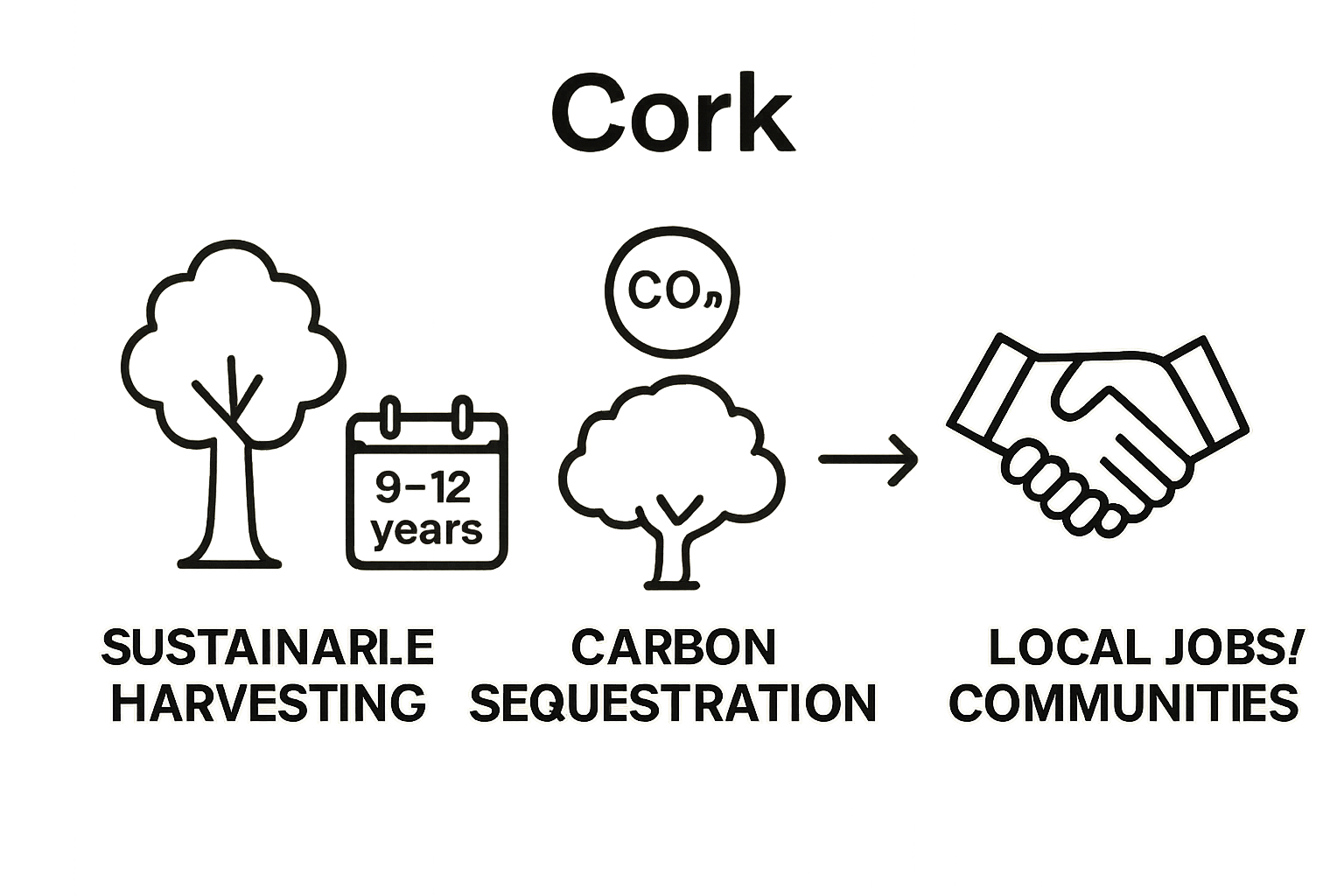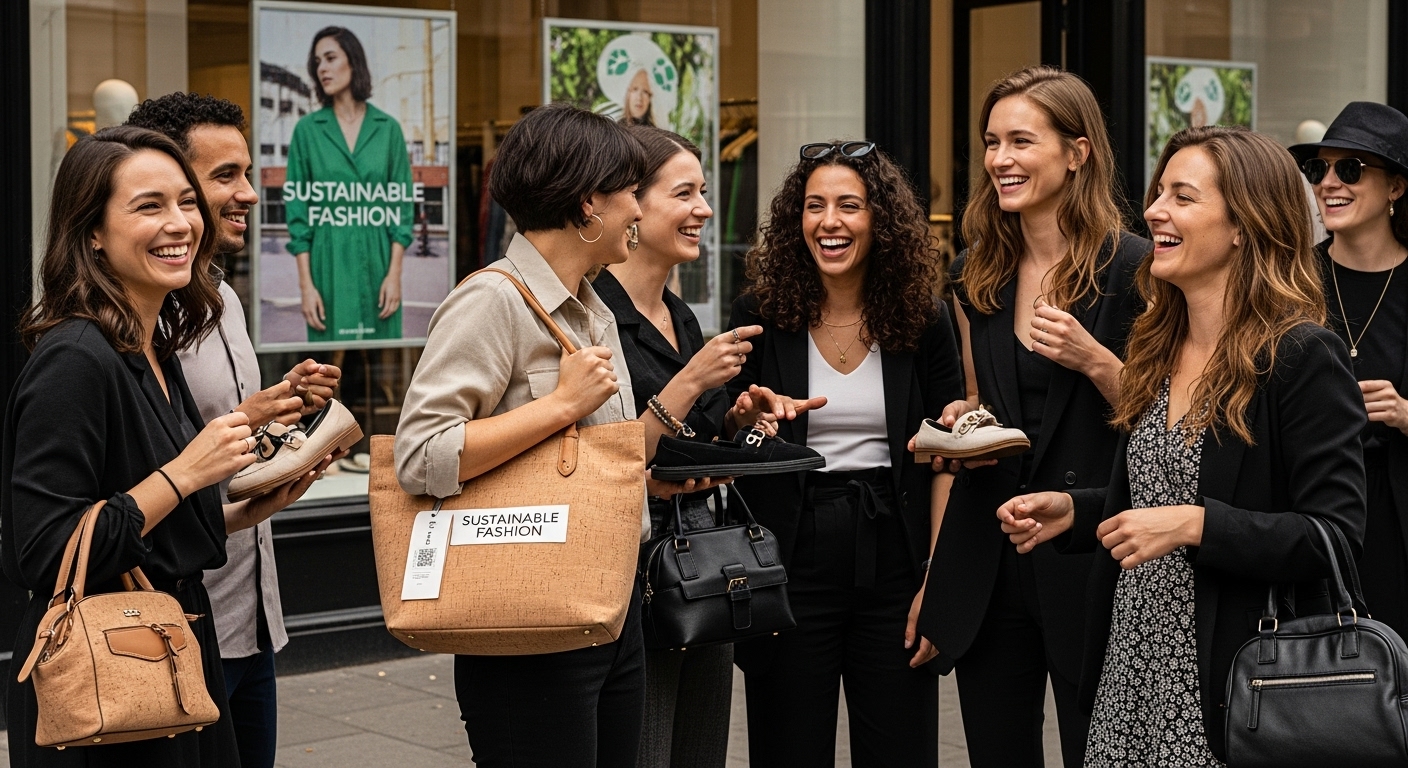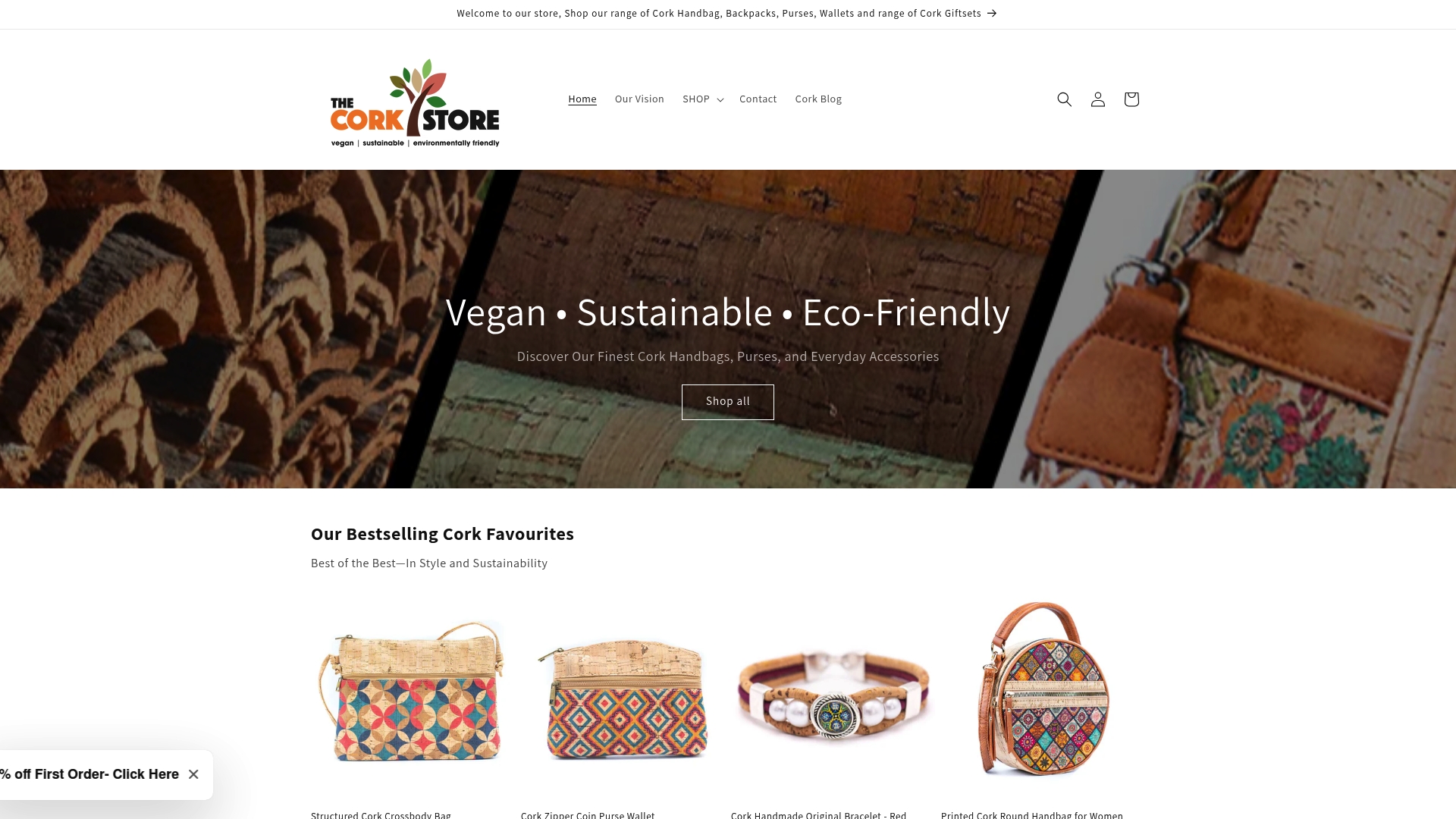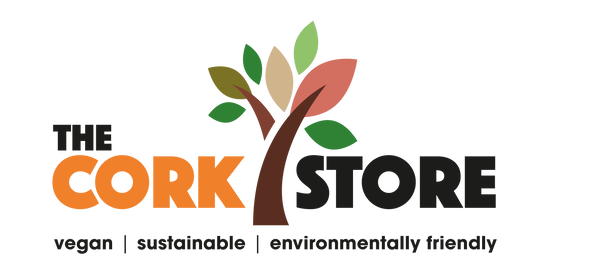
Understanding the Role of Cork in Sustainable Fashion
Share
Cork is quickly turning heads in sustainable fashion circles. Most people have heard that Portugal supplies about 50 percent of all the cork used globally, but few realise just how many roles this eco-friendly material can play in wearable design. It is not just about the numbers or its origins though. The real surprise is how cork’s natural properties rival or even outperform traditional fabrics, bringing comfort, durability and water resistance together in unexpected ways.
Table of Contents
- What Is Cork And Its Properties In Fashion?
- Why Cork Matters In Sustainable Fashion Choices
- How Cork Is Harvested And Processed Sustainably
- Exploring The Benefits Of Cork As A Fashion Material
- Real-World Applications Of Cork In Modern Fashion
Quick Summary
| Takeaway | Explanation |
|---|---|
| Cork is an eco-friendly material | Derived from cork oak trees, cork provides a sustainable alternative to traditional textiles with significant ecological benefits. |
| Cork harvesting promotes sustainability | The harvesting process protects cork oak trees, allowing for continuous carbon sequestration and regeneration without harming the environment. |
| Cork offers unique performance characteristics | Its lightweight, water-resistant, and durable nature makes cork ideal for innovative fashion applications across various products. |
| Cork supports ethical production | The cork industry sustains local economies in producing regions while ensuring fair practices and preserving traditional harvesting techniques. |
| Versatile design opportunities with cork | Designers can creatively manipulate cork to create stylish accessories and clothing, combining sustainability with aesthetic appeal. |
What is Cork and Its Properties in Fashion?
Cork represents a remarkable natural material transforming sustainable fashion through its extraordinary properties and ecological benefits. Originating from the bark of cork oak trees, this versatile substance offers designers and consumers an eco-friendly alternative to traditional synthetic and animal-derived materials.
The Natural Origins of Cork
The cork material begins its journey in Mediterranean regions, specifically Portugal, which produces approximately 50% of global cork supplies. Cork oak trees undergo a unique harvesting process where their bark is carefully stripped without harming the tree, allowing repeated extraction every nine to twelve years. Researchers at the Fashion Institute of Technology have discovered that cork’s cellular structure provides exceptional performance characteristics for textile applications.
Key properties of cork that make it extraordinary for fashion include:
- Lightweight composition enabling comfortable wear
- Water-resistant surface protecting garments and accessories
- Naturally antimicrobial preventing bacterial growth
- Extremely durable maintaining structural integrity over extended periods
Innovative Fashion Applications
Fashion designers are increasingly recognising cork’s potential beyond traditional uses. Its unique texture and sustainable profile allow for creating innovative accessories and clothing items. From handbags to shoes, cork provides a cruelty-free, environmentally conscious alternative that does not compromise on style or quality.
The material’s elasticity, low density, and remarkable adaptability make it an ideal substrate for fashion designers seeking to reduce environmental impact while maintaining aesthetic appeal. By choosing cork, fashion brands can demonstrate commitment to sustainable practices without sacrificing design innovation.
Below is a comparison of cork’s key characteristics with their related benefits in fashion applications, helping to clearly understand why cork stands out as a sustainable material.
| Characteristic | Description | Fashion Benefit |
|---|---|---|
| Lightweight | Low density, naturally light material | Comfortable wear, easy to carry |
| Water-resistant | Naturally repels water | Protects garments and accessories |
| Naturally antimicrobial | Prevents bacterial growth | Hygienic for prolonged wear |
| Extremely durable | Maintains structural integrity over time | Long-lasting products |
| Elasticity | Flexible and resilient | Easily shaped into various designs |
| Hypoallergenic | Suitable for sensitive skin | Safe for all users |
| Unique texture | Natural, visually distinct appearance | Aesthetic versatility |
Why Cork Matters in Sustainable Fashion Choices
Sustainable fashion represents more than a trend—it is a critical response to the environmental challenges posed by traditional textile production. Cork emerges as a transformative material that addresses multiple ecological and ethical concerns within the fashion industry.
Environmental Impact and Carbon Neutrality
Cork’s sustainability extends far beyond its material properties. According to research from environmental sustainability experts, cork oak forests are extraordinary carbon sinks, actively removing carbon dioxide from the atmosphere during the tree’s lifecycle. Each harvested cork oak tree continues to absorb carbon at accelerated rates, making cork a genuinely carbon-negative material.
Key environmental advantages of cork include:

- Zero tree destruction during bark harvesting
- Continuous carbon sequestration throughout the tree’s lifespan
- Biodegradable material with minimal ecological footprint
- Renewable resource that regenerates naturally
Ethical Production and Social Responsibility
Beyond environmental benefits, cork production supports robust economic ecosystems in regions like Portugal and Spain. The cork industry provides sustainable livelihoods for thousands of workers, ensuring fair economic practices while preserving traditional harvesting techniques. Explore our comprehensive guide on sustainable materials to understand how cork contributes to ethical fashion choices.
Fashion brands adopting cork demonstrate a commitment to transparent, responsible production. By selecting materials that prioritize both environmental preservation and human welfare, designers create products that resonate with conscious consumers seeking genuine sustainability.
How Cork is Harvested and Processed Sustainably
Sustainable cork harvesting represents an extraordinary model of environmental stewardship, demonstrating how human economic activities can coexist harmoniously with natural ecosystems.
The intricate process of cork extraction transforms bark removal from a potential destructive practice into a regenerative, environmentally conscious method.
Traditional Harvesting Techniques
Researchers at UC Davis have documented the meticulous art of cork bark extraction, which requires extraordinary skill and precision. Skilled workers use specialised axes to carefully remove the outer bark without damaging the living tree, ensuring the cork oak’s continued health and productivity.
Key steps in traditional cork harvesting include:
The following table outlines the main stages and techniques of traditional cork harvesting, providing a succinct overview of the sustainable process from tree to raw material.
| Harvesting Stage | Technique/Action | Sustainability Contribution |
|---|---|---|
| Tree Selection | Choose mature cork oaks aged 25-30 years | Ensures tree health and optimal quality |
| Manual Stripping | Skilled workers use axes to strip outer bark | No tree harm; enables repeat harvests |
| Precision Cutting | Careful removal to avoid damaging inner tree layers | Maintains tree longevity and regeneration |
| Resting/Recovery Period | Trees left undisturbed for 9-12 years between harvests | Supports ecosystem balance, continuous growth |
- Manual stripping of bark by experienced workers
- Careful selection of mature trees aged 25-30 years
- Precise cutting techniques that protect the tree’s inner layers
- Extended recovery periods between harvests (9-12 years)
Sustainable Processing and Transformation
After harvesting, cork undergoes a sophisticated processing sequence that minimises waste and environmental impact. The raw bark is carefully dried, boiled, and transformed into various fashion materials through innovative techniques that preserve its natural properties.
Fashion designers can explore our complete range of sustainable cork products to understand the intricate journey from forest to fashion accessory. The processing methods maintain the material’s inherent qualities—lightweight structure, water resistance, and remarkable durability—while creating versatile textiles suitable for contemporary sustainable fashion.
Exploring the Benefits of Cork as a Fashion Material
Cork transcends traditional textile expectations, offering fashion designers and consumers a revolutionary material that combines aesthetic appeal with exceptional functional properties. Its unique molecular structure provides performance characteristics that challenge conventional fabric technologies.
Physical and Performance Characteristics
Researchers exploring sustainable textile innovations have discovered cork’s remarkable performance attributes that make it increasingly attractive for fashion applications. The material’s cellular composition delivers a range of extraordinary benefits that distinguish it from traditional textiles.
Key performance advantages of cork include:
- Lightweight structure reducing garment burden
- Exceptional breathability enhancing wearer comfort
- Natural water resistance protecting against environmental conditions
- Hypoallergenic properties suitable for sensitive skin
Aesthetic and Design Versatility
Beyond its technical merits, cork offers fashion designers unprecedented creative flexibility. Its natural texture can be manipulated to mimic leather, create innovative surface treatments, and develop unique visual narratives within sustainable fashion collections. Explore our comprehensive range of cork accessories to witness the material’s design potential.
The adaptability of cork allows designers to experiment with colour, texture, and form while maintaining a commitment to ecological responsibility. By transforming a traditionally industrial material into a fashion statement, cork challenges preconceived notions about sustainable textile design.
Real-World Applications of Cork in Modern Fashion
Cork has emerged from its traditional utilitarian roots to become a cutting-edge material revolutionising sustainable fashion across multiple product categories. Its versatility enables designers to reimagine textile and accessory production through an environmentally conscious lens.
Innovative Fashion Product Categories
Researchers investigating sustainable textile innovations have documented cork’s expanding role in contemporary fashion design. The material now spans an impressive range of applications, from haute couture to everyday accessories, challenging conventional perceptions of sustainable materials.
Key fashion applications of cork include:
- Handbags and accessories offering cruelty-free alternatives to leather
- Footwear providing lightweight and durable shoe constructions
- Outerwear creating breathable and water-resistant jackets
- Jewellery developing unique textural statement pieces
This table summarises the major contemporary fashion categories in which cork is applied, showcasing the material’s versatility and eco-friendly advantages for each product type.
| Product Category | Example Products | Sustainable/Performance Benefit |
|---|---|---|
| Handbags & Accessories | Handbags, wallets, belts | Cruelty-free, eco-friendly alternatives to leather |
| Footwear | Shoes, sandals | Lightweight, durable, water-resistant |
| Outerwear | Jackets, hats | Breathable, water-resistant, comfortable |
| Jewellery | Earrings, necklaces | Unique texture, hypoallergenic, lightweight |
Emerging Design Approaches
Designers are increasingly viewing cork not merely as a material but as a medium for storytelling and environmental advocacy. Contemporary fashion brands integrate cork to communicate their commitment to sustainable production methods. Discover innovative styling techniques for cork accessories that demonstrate the material’s remarkable adaptability.
The transformation of cork from an industrial material to a fashion-forward textile represents a paradigm shift in sustainable design. By embracing this extraordinary material, fashion brands can create products that are simultaneously aesthetically compelling and environmentally responsible.

Discover Real Solutions for Sustainable Style with Cork
Making sustainable fashion choices can feel overwhelming when traditional materials harm the planet and animals. This article highlights the unique benefits of cork—such as its renewability, durability, and water resistance—yet many shoppers still struggle to find stylish, truly eco-friendly accessories that match their values. If you are searching for fashion that aligns with your ethical goals and supports a healthier planet, your journey does not need to stop at information.
Experience the difference with our vegan cork collection, where every handbag, wallet, and accessory is crafted to combine beauty with environmental responsibility. Each product at The Cork Store offers comfort, long-lasting quality, and peace of mind that your purchase supports ethical manufacturing and green innovation.

Ready to wear your values? Explore our curated range of sustainable cork bags and gifts on The Cork Store. For more inspiration or to learn how cork can elevate your wardrobe, browse our blog on eco-friendly materials now. Make your move towards a kinder, greener wardrobe today.
Frequently Asked Questions
What are the key properties of cork that make it suitable for fashion?
Cork is lightweight, water-resistant, naturally antimicrobial, and extremely durable, making it an excellent material for fashion applications.
How is cork harvested, and why is it considered sustainable?
Cork is harvested by manually stripping the bark from cork oak trees without damaging them, allowing for renewable harvests every nine to twelve years. This process does not involve tree destruction, supporting a sustainable ecosystem.
What types of products can be made from cork in the fashion industry?
Cork is increasingly used to create a variety of products, including handbags, footwear, outerwear, and jewellery, providing an eco-friendly alternative to traditional materials like leather.
How does cork contribute to ethical fashion practices?
The cork industry supports sustainable livelihoods and fair economic practices for workers involved in harvesting and processing. By choosing cork, fashion brands align themselves with responsible production and environmental preservation.
Recommended
- Understanding the Role of Eco-Friendly Materials in Fashion – The Cork Store
- 7 Types of Sustainable Materials for Eco-Friendly Living – The Cork Store
- Understanding What Makes Vegan Handbags Eco-Friendly – The Cork Store
- Buy Cork Products, Bags, Handbags & Accessories | Free UK Delivery – The Cork Store
